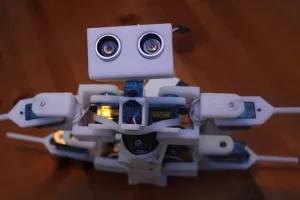
What are Proximity Sensors: Types, Working Principle and Applications
December 07 2023 
Inquiry
Global electronic component supplier AMPHEO PTY LTD: Rich inventory for one-stop shopping. Inquire easily, and receive fast, customized solutions and quotes.
QUICK RFQ
ADD TO RFQ LIST
In this blog, the basics of proximity sensors will be explored to help readers more understand this excellent sensor.
What are Proximity Sensors?
Proximity sensors are electronic devices that are designed to detect the presence or absence of objects within a certain range without physical contact. They are widely used in various industries and applications, from automotive and manufacturing to robotics and consumer electronics. Proximity sensors work based on different principles, including electromagnetic, capacitive, inductive, ultrasonic, and optical technologies. Proximity sensors offer several advantages in various applications. They provide non-contact detection, which eliminates the need for physical contact with the object being detected, reducing wear and tear and enabling faster detection. Proximity sensors are also highly reliable and durable, with long service lives and resistance to environmental factors such as dust, moisture, and vibration. They can operate in harsh conditions and are capable of detecting objects regardless of their color, shape, or material composition. Overall, proximity sensors play a crucial role in automation, robotics, and numerous other industries by enabling accurate and efficient object detection and position sensing. Their versatility and reliability make them essential components in a wide range of applications where the presence or absence of objects needs to be detected without direct physical contact.
Proximity Sensors Types
There are several types of proximity sensors, each with its own unique characteristics and operating principles.- Capacitive Sensors:
- Inductive Sensors:
- Ultrasonic Sensors:
- Infrared Sensors:
- Photoelectric Sensors:
How Proximity Sensors Work?
Proximity sensors work based on different principles depending on their technology. Let's explore how each type of proximity sensor operates:- Electromagnetic Proximity Sensors: These sensors use the principle of electromagnetic induction. They consist of a coil that generates an electromagnetic field. When a metallic object enters this field, it disrupts the field, causing a change in the sensor's output signal. This change is detected by the sensor, indicating the presence of the object. The sensor's output can be in the form of a voltage, current, or a switching signal.
- Capacitive Proximity Sensors: Capacitive sensors operate by measuring changes in capacitance. They consist of two electrodes separated by a dielectric material. When an object enters the sensor's electrostatic field, it alters the capacitance between the electrodes. This change in capacitance is detected by the sensor, triggering a response. Capacitive sensors are sensitive to the electrical properties of objects, and they can detect both metallic and non-metallic materials.
- Inductive Proximity Sensors: Inductive sensors also utilize electromagnetic induction. They consist of a coil that generates a high-frequency electromagnetic field. When a metallic object enters the sensor's field, it induces eddy currents in the object. These currents create a magnetic field that interacts with the sensor's coil, resulting in a change in the sensor's output. The sensor can detect this change and determine the presence of the object.
- Ultrasonic Proximity Sensors: Ultrasonic sensors use sound waves to detect objects. They emit high-frequency ultrasonic waves and measure the time it takes for the waves to bounce back after hitting an object. The sensor emits a pulse and listens for the echo. By analyzing the time delay between the emitted pulse and the received echo, the sensor can calculate the distance to the object. Ultrasonic sensors are effective for both short-range and long-range detection.
- Optical Proximity Sensors: Optical sensors rely on the detection of light or infrared radiation. They emit a beam of light and measure the intensity of the reflected light. When an object enters the sensor's field, it either reflects the emitted light to the sensor or absorbs it. By analyzing the intensity of the reflected light, the sensor can determine the presence or absence of the object.

How to Switch Off Proximity Sensors?
Switching off proximity sensors typically depends on the specific system or device in which they are installed. Here are a few common methods used to deactivate or disable proximity sensors: Physical Obstruction: One straightforward approach to turning off a proximity sensor is to physically obstruct it. This can be done by placing an opaque object, such as tape or a non-transparent material, in front of the sensor. By blocking the sensor's field of detection, it effectively prevents it from sensing objects and triggering any associated actions or responses. Software or Firmware Settings: Many proximity sensors are integrated into electronic devices that offer configurable settings through software or firmware. These settings allow users to customize the behavior of the sensor or disable it altogether. By accessing the device's settings menu or control panel, users can navigate to the proximity sensor options and disable its functionality. This method is commonly used in smartphones, tablets, and other consumer electronics. Circuit Disconnection: In some cases, proximity sensors can be deactivated by physically disconnecting them from the circuitry. This method requires technical knowledge and may involve opening the device or system to access the sensor's wiring or connector. By disconnecting the sensor's power supply or removing it from the circuit, its functionality can be effectively switched off. However, this approach should be performed with caution to avoid damaging the device or affecting its overall operation. Disabling via Control Signals: Proximity sensors used in industrial automation systems or robotics can often be controlled via external signals. These signals can be generated by a programmable logic controller (PLC) or a microcontroller, which can send a command to disable the sensor. By programming the system to send a specific signal to the sensor, it can be turned off or put into standby mode to suspend its operation temporarily. Power Source Interruption: Another way to switch off proximity sensors is by interrupting their power source. This can involve disconnecting the power supply or switching off the device or system in which the sensor is installed. By cutting off the power, the sensor ceases to function until power is restored.Proximity Sensors Applications
Proximity sensors, with their ability to detect the presence of nearby objects without any physical contact, have revolutionized the way we interact with the world around us. From everyday consumer devices to complex industrial applications, these ingenious sensors are silently working behind the scenes, making our lives safer, more convenient, and more efficient. Consumer Electronics:- Smartphones: Proximity sensors in smartphones detect when you hold the phone to your ear, automatically turning off the screen and preventing accidental touches.
- Tablets: These sensors enable touch-sensitive screens and allow for features like gesture recognition.
- Wearables: Fitness trackers and smartwatches use proximity sensors to detect when you're wearing them and adjust their functionality accordingly.
- Smart Home Devices: Proximity sensors in smart speakers and lights can detect your presence and automatically turn on or off, creating a more personalized and convenient experience.
- Parking Sensors: These sensors help drivers park safely by detecting obstacles and sounding an alarm when the car gets too close.
- Adaptive Cruise Control: Proximity sensors enable this technology to automatically adjust the car's speed based on the distance to the vehicle in front.
- Blind Spot Monitoring: These sensors warn drivers when another vehicle is in their blind spot, reducing the risk of accidents.
- Collision Avoidance Systems: By detecting obstacles and pedestrians, these systems can automatically apply the brakes or take other evasive actions to prevent accidents.
- Assembly Lines: Proximity sensors are used in robots and machinery to detect the presence of parts and ensure proper assembly and handling.
- Conveyor Belts: These sensors accurately detect objects on conveyor belts, facilitating sorting, counting, and packaging tasks.
- Material Handling: Proximity sensors ensure the safe and efficient movement of materials in warehouses and production facilities.
- Quality Control: By detecting defects in products, these sensors help maintain quality standards and improve production efficiency.
- Motion Detectors: These sensors trigger alarms when they detect movement, deterring intruders and protecting property.
- Access Control Systems: Proximity sensors are used in key cards and badges to grant access to restricted areas.
- Intruder Detection Systems: These systems can detect intruders based on their movement and heat signatures, providing early warnings and enhancing security.
- Perimeter Security: Proximity sensors can be used to create invisible fences around buildings and sensitive areas, triggering alarms when breached.
- Medical devices: Proximity sensors are used in various medical devices, such as blood pressure monitors and glucose meters, to improve accuracy and convenience.
- Gaming: These sensors can be used in-game controllers and virtual reality headsets to provide more immersive and interactive gaming experiences.
- Smart Buildings: Proximity sensors can be used to optimize energy usage in buildings by automatically adjusting lighting and temperature based on occupancy.
- Public Transportation: These sensors can be used to improve passenger safety and convenience in public transportation systems.
The Future of Proximity Sensors
As technology advances, proximity sensors are becoming smaller, more efficient, and more affordable. This trend is expected to further accelerate the adoption of these sensors in various applications, shaping the future of automation, robotics, and the Internet of Things (IoT). With endless possibilities, proximity sensors promise to continue revolutionizing the way we interact with the world, making it safer, more convenient, and more connected.Related Articles
Populer Posts
M5LV-384/120-10YC-12YI
Lattice Semiconductor
XC3020-PC84C
AMD
XC3030L-8VQ100C
AMD
M2GL005-TQ144
Microsemi
XC3090-100PC84I
AMD
XC3030-PC44BK
AMD
XC3030-25PC84I
AMD
XC2S150E-3FG456C
AMD
XC3164A-09PQ160C
AMD
AFS090-QNG108
Microsemi
